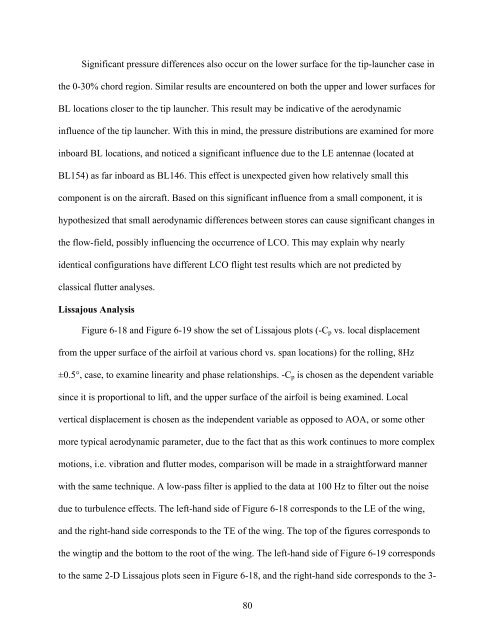university of florida thesis or dissertation formatting template
university of florida thesis or dissertation formatting template
university of florida thesis or dissertation formatting template
Create successful ePaper yourself
Turn your PDF publications into a flip-book with our unique Google optimized e-Paper software.
Significant pressure differences also occur on the lower surface f<strong>or</strong> the tip-launcher case in<br />
the 0-30% ch<strong>or</strong>d region. Similar results are encountered on both the upper and lower surfaces f<strong>or</strong><br />
BL locations closer to the tip launcher. This result may be indicative <strong>of</strong> the aerodynamic<br />
influence <strong>of</strong> the tip launcher. With this in mind, the pressure distributions are examined f<strong>or</strong> m<strong>or</strong>e<br />
inboard BL locations, and noticed a significant influence due to the LE antennae (located at<br />
BL154) as far inboard as BL146. This effect is unexpected given how relatively small this<br />
component is on the aircraft. Based on this significant influence from a small component, it is<br />
hypothesized that small aerodynamic differences between st<strong>or</strong>es can cause significant changes in<br />
the flow-field, possibly influencing the occurrence <strong>of</strong> LCO. This may explain why nearly<br />
identical configurations have different LCO flight test results which are not predicted by<br />
classical flutter analyses.<br />
Lissajous Analysis<br />
Figure 6-18 and Figure 6-19 show the set <strong>of</strong> Lissajous plots (-Cp vs. local displacement<br />
from the upper surface <strong>of</strong> the airfoil at various ch<strong>or</strong>d vs. span locations) f<strong>or</strong> the rolling, 8Hz<br />
±0.5°, case, to examine linearity and phase relationships. -Cp is chosen as the dependent variable<br />
since it is prop<strong>or</strong>tional to lift, and the upper surface <strong>of</strong> the airfoil is being examined. Local<br />
vertical displacement is chosen as the independent variable as opposed to AOA, <strong>or</strong> some other<br />
m<strong>or</strong>e typical aerodynamic parameter, due to the fact that as this w<strong>or</strong>k continues to m<strong>or</strong>e complex<br />
motions, i.e. vibration and flutter modes, comparison will be made in a straightf<strong>or</strong>ward manner<br />
with the same technique. A low-pass filter is applied to the data at 100 Hz to filter out the noise<br />
due to turbulence effects. The left-hand side <strong>of</strong> Figure 6-18 c<strong>or</strong>responds to the LE <strong>of</strong> the wing,<br />
and the right-hand side c<strong>or</strong>responds to the TE <strong>of</strong> the wing. The top <strong>of</strong> the figures c<strong>or</strong>responds to<br />
the wingtip and the bottom to the root <strong>of</strong> the wing. The left-hand side <strong>of</strong> Figure 6-19 c<strong>or</strong>responds<br />
to the same 2-D Lissajous plots seen in Figure 6-18, and the right-hand side c<strong>or</strong>responds to the 3-<br />
80
















